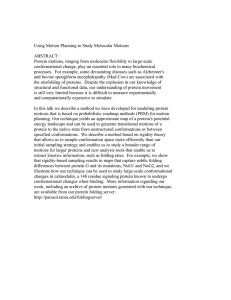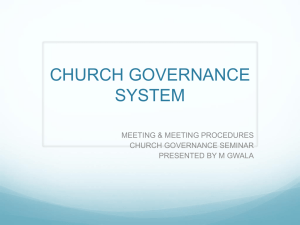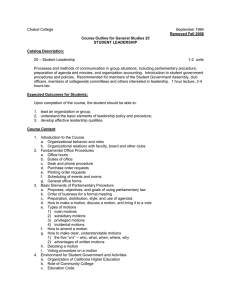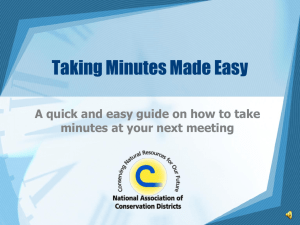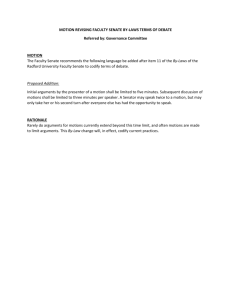1
advertisement
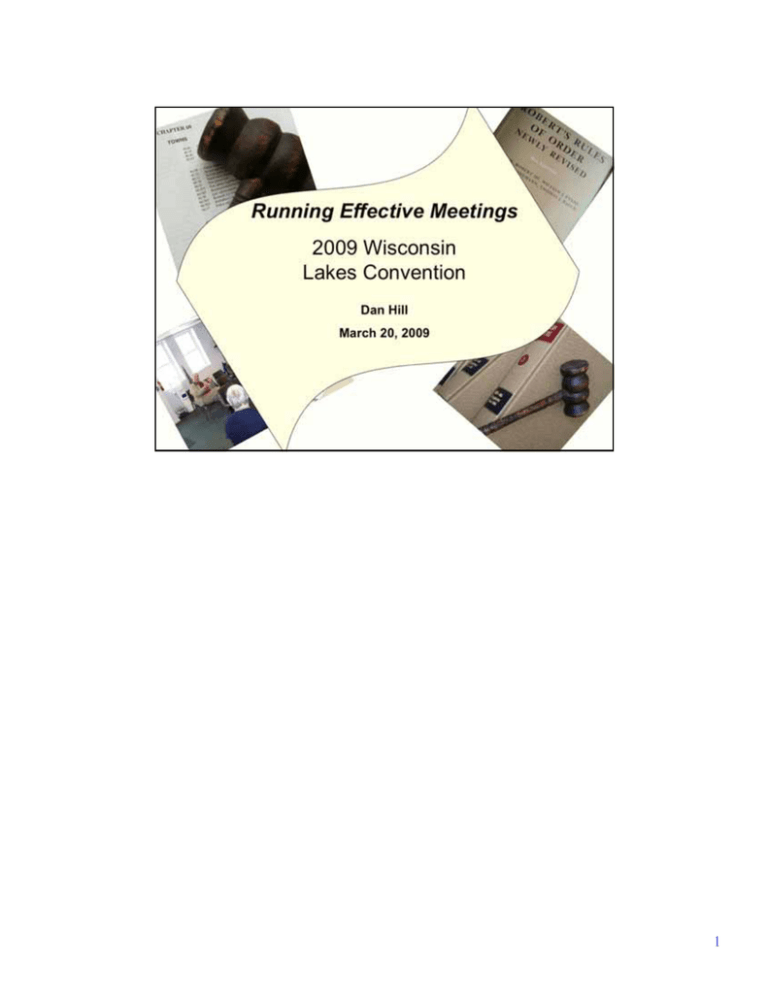
1 Anyone ever been to a bad meeting? So, what makes it so hard to get the marbles in the holes at the same time. In the case of conducting a meeting, why can it be so difficult? The same thing that makes meetings productive, can make meetings frustrating. 2 Different temperaments. Different expectations—leadership group. What did they say? All agree that being treated fairly is critical to an effective meeting. 3 Analytical Good Meeting Focused on issues Clear purpose Exhaust all the options to make the best decision Justification for all actions—answers the question “why” 4 5 6 All of these folks want fairness 7 Previous information was more about the artistry of preparing for and conducting effective meetings. There are however, prescribed ways of conducting meetings. These prescriptions are found in: Wisconsin Statutes—Open meetings law Local Rules—Local units of government may create their own rules subject to higher law. Cannot disregard state statutes because you created a local rule. Back of county directory Robert’s Rules of Order These rules are in place to assure fairness, not to be abused to “catch” people. Listed in order of highest to lowest authority. 8 9 10 11 12 13 14 15 16 17 18 Motions should be clearly stated As the tape shows, the use of “so moved” should be avoided. Beyond that, motions should be worked out in advance – even before the meeting -- if possible. In the case of procedural motions, amendments, or any other motion that arises spontaneously, take the time to get the wording down clearly for the sake of the minute-taker and also so that all members are clear as to what they’re voting on. No “friendly amendments” or unilateral withdrawal of motions At issue here is the concept of ownership of motions. Until a motion is “stated by the chair” – i.e., the chairperson says “it has been moved and seconded that ... “ or some such language, the motion “belongs” to the mover and, upon its being seconded, to the mover and seconder. As a practical matter, if a motion arises spontaneously, such as, for example, a motion to amend a pending main motion, the mover and seconder of the amendment can alter the proposed amendment up to the time it is stated by the chair. In some cases, the motion is worked out in advance and is printed in the meeting’s public notice or agenda as might be the case of a committee recommendation. In this situation, the mover, whether an individual member or a committee can alter the motion or choose not to submit it. However, once the motion has been put to the body by the chair the motion belongs to the body and it cannot be amended or withdrawn without the consent of the body. Thus, the “friendly amendment” approach in which someone suggests a change in the motion and asks for the mover’s approval is an improper procedure. Such a suggestion should be directed to the body for its approval. (An old line from parliamentary procedure lore which has some humor value and may help in retention of the concept is, “Amendments don’t have sentiments.”) Similarly, a motion that the maker wants to withdraw after it has been stated by the chairperson can be withdrawn only with the consent of the group. Quite often minor changes in the wording of a motion or a request to withdraw a motion are not controversial and the body takes such action by unanimous consent as discussed below. [NOTE: The facilitator may want to direct participants to the chart, “Basic Information on Motions,” and note that withdrawing a motion on the part of the mover is a request that the mover makes to the group and the consent of the majority (often obtained by unanimous consent as discussed below) is required to grant the request. NOTE ALSO: These procedures, especially withdrawing a motion, may be matters addressed by the body’s own rules and, if so, the body’s own rules, if different from what is presented here, would prevail. For example, the League of Wisconsin Municipalities suggested ordinances for villages and cities provides for a different approach to withdrawing motions. If the body follows the League’s suggested ordinances a motion may be withdrawn by the mover with the consent of the seconder.] 19 Only one main motion can be pending at a time Under the Robert system, motions that are actions of the body such as ordinances, resolutions, and actions of lesser scope such as purchases, are regarded as main motions. To keep the body’s proceedings clear and orderly, only one main motion can be pending at a time. A main motion that is offered while another one is pending is out of order. (NOTE: “Pending” means that a motion has been moved, seconded, and stated by the chair and is now owned by the body and is the primary focus of the body’s attention.) (NOTE: It will be useful to refer to the chart “Basic Information on Motions” as the next bullet is discussed.) Other classes of motions take precedence over main motions Robert, as well as other parliamentary systems, recognizes classes of motions other than main motions. Motions that affect the treatment or substance of main motions are called “subsidiary motions” and can be made while a main motion is pending. If a subsidiary motion is relevant and otherwise in order, it will, upon being moved, seconded, and stated by the chair, replace the main motion as the focus of the body’s attention and is said to be “immediately pending.” If a subsidiary motion is passed the main motion is affected by whatever action the subsidiary motion proposed. If a subsidiary motion fails, the body’s attention returns immediately to the pending main motion. The chart indicates a ranking among subsidiary motions. Those appearing above the others on the chart take precedence over those listed below. Thus, for example, it is in order to move to refer a pending main motion and a pending amendment to the main motion to a committee. When the motion to refer is made, seconded and stated by the chair, it becomes immediately pending. If the motion to refer is adopted, the main motion and the amendment are sent to the committee to be treated in accordance with instructions contained in the motion to commit or in accordance with the customary practices of the local government body. If the motion to commit fails, the body’s attention returns to the motion to amend. Motions that are more concerned with event of the meeting – for example, whether members can participate without distraction, whether or not to recess, whether the body is attending to the business it should be at a particular time, or whether to adjourn – are called “privileged motions.” Any of the privileged motions can be made while a main motion or any of the subsidiary motions is pending. Like subsidiary motions, privileged motions have a rank among themselves. Thus, a privileged motion above any other privileged motion can be made while the lower ranking motion is pending. Some motions, requests, inquiries and points or order, called “incidental motions,” are situation specific and, if relevant to the situation at hand, are in order when motions of other classes are pending and will take precedence over those pending motions. 20 Decisions can be reconsidered The rationale for permitting reconsideration is to enable a member of the body to point out that relevant information or insight was not taken into account prior to making a decision. In order to prevent a minority from bogging down the body’s processes, only a member who voted on the prevailing side may move reconsideration. This restriction does not apply to the seconder – any member can second reconsideration regardless of how s/he voted in the original decision. To keep the process from bogging down, reconsideration must be moved in a timely manner. The body may have it’s own rules regarding the window within which the motion must be made or it may have adopted the League of Wisconsin Municipalities’ sample ordinances that provide that reconsideration must be moved in the same meeting as the original decision or at the next succeeding meeting. If the body has no rules of its own governing reconsideration but follows Robert’s, decisions can be reconsidered only in the meeting in which the decision was originally made. If the body agrees to reconsider a decision, it only agrees to re-open it and discuss it further. When a formal main motion is under reconsideration, any of the subsidiary motions may be applied to it. When the motion is finally voted on again the outcome may be the same as the original decision - reconsideration does not necessarily result in a changed decision. If the body’s rules permit moving to reconsider at a meeting subsequent to the one in which the decision was made, the actual reconsideration cannot take place unless the issue is on the meeting’s public notice. If the issue is not on the public notice, it appears that the body can agree to reconsider a decision at a future meeting when public notice can be provided. 21 Postponing to a specific time creates an “order of the day” When the body agrees, by motion or unanimous consent, to postpone consideration of a pending motion to a specific time, it mandates that the motion will be taken up at the time so designated. The time specified for taking up the postponed matter may be a specific time in the same meeting, a later meeting, or a specific time in a later meeting. If the designated time is a future meeting, the pending matter would be placed on that meeting’s agenda prior to any “new business” – i.e., items that are not carried over in some manner from previous meetings. If the postponement is mandated for a time specific, either in the current meeting or some future meeting, the body has created a “special order of the day,” which means that when the designated time arrives, the body must interrupt whatever it is attending to and take up the postponed matter. However, they may postpone the matter again in order to get back the issue that was interrupted. [NOTE: At this point, it might be useful to refer participants to the chart of motions and point out that the privileged motion, “call for the orders of the day” is used when a member wants to point out that postponed matters or other matters are not being attended to at the times they should be.] Tabling simply sets the motion aside When the body “tables” a pending motion it agrees to set it aside, presumably to take up an issue deemed more important. Tabling a motion does not create an order to get back to the tabled matter at any time or at all. If the body decides to resume deliberation on the tabled matter, a group decision in the form of unanimous consent or a formal motion is required. Often a member will move to “table” a pending matter until the next meeting. In this case, the member intends to have the motion come up at the designated time and his/her motion should be regarded as a motion to postpone to a specific time. A proper use of the motion to table would occur if the body is has taken up a particular item on the agenda and realizes that a resource person with information on the item has not yet arrived at the meeting. The body could set aside or “table” the pending matter to take up another item. When the resource person arrives, the body could move to take the tabled matter from the table but has not committed itself to do so at that time or at all because they may deem other matters as more important. 22 23 Chairperson is responsible for the agenda. Content, distribution, and use. Group may require chair to vacate the chair during participation. Group can not require chair to remain in chair and refrain from discussion. Chairperson is responsible for administering the group’s deliberations. 24 Announces issue, keeps members on track. Restates motions for clarity. Seek balance. Recognize members. Enforces group’s rules. 25 Responds to request. Subject to appeal. 26 27 Adjourned meeting—p. 7-8 Quorum must vote—p. 11 Majority of those voting needed to pass. 9 of 16 present would not allow for anyone to abstain. Only 5 needed to pass if all 9 vote. If in room, you are present—don’t vote=abstain. Chairperson is responsible for the agenda. Content, distribution, and use. 28 29

